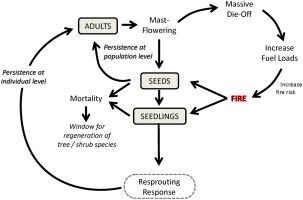Acta Oecologica ( IF 1.3 ) Pub Date : 2020-08-18 , DOI: 10.1016/j.actao.2020.103623 Laura Cavallero , Melisa Blackhall

|
Chusquea culeou is a semelparous bamboo species which dominates the understorey of temperate forests and shrublands of Patagonia, South America. After the massive flowering, seeding and subsequent die-off, it provides an extraordinary amount of fine and dry fuel that increases wildfire likelihood, which in turn threatens the survival of its own offspring. In this context, we tested if this species could have alternative survival mechanisms which allows the persistence of the single seedling cohort, specifically evaluating two stages: seed and seedling. After a massive flowering event that occurred in summer 2010–11 and reached a regional scale in north-western Patagonia, we experimentally tested: 1) the effect of heat (90 °C, 120 °C, 150 °C) and/or ash on germination capacity of C. culeou seeds; and 2) the effect of low to moderate intensity fires on resprouting response of seedlings (<2 yr). Heating treatments inhibited seed germination, whereas most of the seedlings survived after their above-ground biomass was burned. Resprouting ability increased with maximum temperature reached at shoot base. Post-fire survival was considerably high, since 68% of pots had surviving shoots at the end of the experiment. In a scenario of wildfire occurrence after a massive flowering and subsequent die-off event, our experimental results suggest that resprouting ability right from the seedling stage might ensure the persistence of C. culeou populations. Also, the differential vegetative response of the seedlings to distinct fire-intensities could trigger distinct recovery trajectories in the understorey, generating an opportunity for regeneration of other trees and/or shrub species.
中文翻译:

重新发芽增加了同种竹种火灾后幼苗持久性的可能性
Chusquea culeou是一种片状竹种,在南美洲巴塔哥尼亚的温带森林和灌木丛中占主导地位。在大量开花,播种和随后死亡之后,它提供了大量的细粉和干燃料,从而增加了野火的可能性,进而威胁到其后代的生存。在这种情况下,我们测试了该物种是否可以具有其他生存机制,该生存机制允许单个幼苗队列的持久性,特别是评估两个阶段:种子和幼苗。在2010-11夏季发生了大规模的开花事件并在巴塔哥尼亚西北部达到了区域规模后,我们通过实验进行了测试:1)热量(90°C,120°C,150°C)和/或灰分的影响对C. culeou的萌发能力种子 2)中低强度火种对幼苗再发响应(<2年)的影响。加热处理抑制了种子发芽,而大多数幼苗在其地上生物量燃烧后得以存活。发芽能力随着芽基部达到最高温度而增加。射击后的存活率很高,因为在实验结束时68%的花盆都有存活的芽。在大量开花和随后的死亡事件后发生野火的情况下,我们的实验结果表明,从苗期开始的重新发芽能力可能确保C. culeou的持久性人口。同样,幼苗对不同火势的不同营养反应可能触发地下层的不同恢复轨迹,从而为其他树木和/或灌木物种的再生提供了机会。











































 京公网安备 11010802027423号
京公网安备 11010802027423号